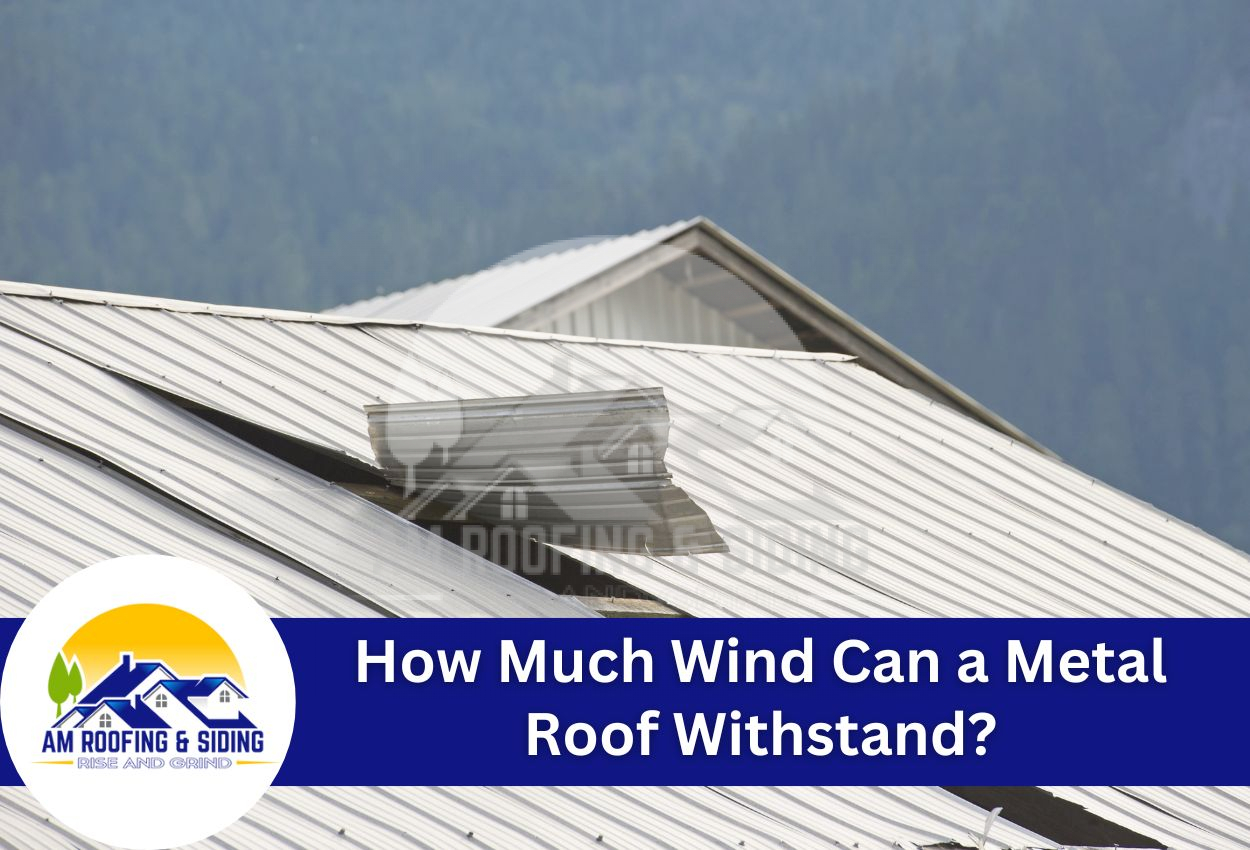Metal roofs are becoming increasingly popular, especially in areas prone to high winds. Their durability and longevity make them an excellent choice for homeowners looking to protect their property against harsh weather conditions. But how much wind can a metal roof withstand? This question is at the heart of what many residents in wind-prone regions need to know before making a roofing decision.
The importance of wind resistance in roofing materials cannot be understated. A roof’s ability to withstand high winds is crucial for the safety and security of the structure it covers. Metal roofs are often favored for their superior performance in extreme weather, including high wind conditions. With various types of metal roofs available, it’s essential to understand which one suits your specific needs best.
Throughout this article, we will explore the factors that contribute to the wind resistance of metal roofs, discuss different wind ratings for metal roofs, and identify the best metal roofs for high winds. Whether you’re considering a new installation or assessing the suitability of a metal roofing system for your building, understanding these elements will help you make an informed decision.
Key Factors Affecting the Wind Resistance of Metal Roofs
The ability of a metal roof to withstand intense wind conditions hinges on several critical factors, including the material composition and the design and construction elements. These aspects are essential in ensuring that your roof can handle the challenges posed by high winds, particularly in areas like Central Ohio, where weather can be unpredictable.
Material composition plays a pivotal role in the durability of metal roofs under high wind conditions. Metals such as aluminum and steel are commonly used for roofing due to their strength and resilience. The thickness and quality of the metal also affect its wind resistance. A higher gauge metal, which indicates a thicker material, typically offers better resistance against the forces of wind.
In addition to material choice, the design and construction of the metal roof are crucial for enhancing its wind resistance. Features such as interlocking panels and proper fastening systems help secure the roof to the building structure, minimizing the risk of uplift in high winds. The shape of the roof also influences its ability to withstand wind. For instance, a sloped roof tends to perform better in wind uplift tests than a flat one.
For homeowners in Central Ohio considering a metal roof, it’s important to select a product with a suitable wind rating. Opting for metal roofing systems designed specifically for high winds can significantly increase the longevity and safety of your home.
Wind Rating for Metal Roofs Explained
Understanding the wind rating for metal roofs is crucial for homeowners, especially those residing in areas susceptible to severe weather conditions. Wind rating refers to the measure of a roof’s ability to withstand high winds without sustaining damage. This rating is determined through rigorous testing, where metal roofs are subjected to various wind speeds to observe their performance and resilience.
Choosing a metal roof with an appropriate wind rating is vital for ensuring the safety and durability of your home. In regions like Central Ohio, where storms and high winds can occur unexpectedly, having a metal roof with a high wind rating can mean the difference between a secure home and costly damages. It is also important to select a metal roof that not only meets but exceeds local building code requirements for wind resistance.
When considering metal roof wind resistance, homeowners should be aware of the specific ratings that indicate how much wind a metal roof can withstand. These ratings help in selecting the best metal roofs for high winds, ensuring that the roof will perform well under extreme conditions. Additionally, understanding the durability of metal roofing in wind can guide homeowners in making informed decisions about roof installation and maintenance to enhance wind protection.
Overall, investing in a high-quality, properly rated metal roof is a wise decision for those looking to improve their home’s resilience against nature’s elements. By choosing the right metal roof with optimal wind resistance, you can significantly increase the protection and longevity of your property.
Comparing Metal Roofs with Other Roofing Materials
When evaluating the suitability of roofing materials for high-wind scenarios, metal roofs often stand out due to their exceptional strength and resilience. Unlike traditional materials such as shingles or tiles, metal roofs offer superior protection against wind uplift and debris impact. This section will delve into the strengths of metal roofs compared to other materials.
Metal roofing systems are designed with wind resistance in mind, featuring interlocking panels that provide an added layer of security against high winds. This design significantly reduces the risk of damage and uplift during wind events, which is a common issue with other roofing materials. For example, because asphalt shingles and clay tiles are installed with individual pieces, they are more susceptible to blow-offs and wind damage. Additionally, the durability of metal roofing in wind is enhanced by its ability to distribute the wind load evenly across the structure, reducing the likelihood of failure.
Overall, metal roof wind resistance not only provides peace of mind but also offers a long-term, cost-effective solution for homeowners in wind-prone regions. By installing metal roofs for wind protection, residents can significantly enhance the safety and durability of their homes.
Best Practices in Metal Roof Installation for Enhanced Wind Resistance
Installing a metal roof requires precise techniques and the right tools to ensure optimal wind resistance. Proper installation is crucial, as the strength of a metal roof against high winds depends significantly on how well it is attached to the structure. This section discusses essential practices and common errors to avoid during metal roof installation.
One fundamental technique in enhancing metal roof wind resistance is the use of appropriate fastening systems. Using screws rather than nails, ensuring that fasteners are spaced correctly, and verifying that they are deep enough into the roof framing, are all critical steps. These practices help secure the roof effectively, minimizing the risk of uplift in extreme wind conditions.
However, installation errors can significantly compromise a metal roof’s ability to withstand high winds. Common mistakes include improper fastener installation, inadequate sealing of the roof edges, and neglect of the manufacturer’s installation guidelines. Such errors not only reduce the wind resistance of the roof but can also lead to costly repairs over time.
To ensure the highest level of wind protection, it is advisable to hire experienced professionals who specialize in metal roof installations. This approach guarantees that all aspects of the installation are handled correctly, from selecting the right materials with appropriate wind ratings to implementing best practices specifically suited for high-wind areas like Central Ohio.
Understanding and applying these best installation practices can significantly influence how much wind a metal roof can withstand, ensuring the safety and longevity of the structure in wind-prone regions.
Maintenance Tips for Ensuring Long-Term Wind Resistance of Metal Roofs
Regular maintenance is crucial to preserve the wind resistance of metal roofs. By conducting routine checks and addressing vulnerabilities promptly, homeowners can ensure their roofs remain in top condition and capable of withstanding high winds. This section will cover essential maintenance activities and tips on identifying potential issues with your metal roof.
Conducting routine inspections is a fundamental practice for maintaining the integrity of a metal roof. It is advisable to inspect your roof at least twice a year, especially after severe weather events. Look for signs of wear and tear, such as loose or missing fasteners, rust, or damaged panels. These issues, if not addressed promptly, can compromise the roof’s ability to withstand high winds.
Another key aspect of maintenance is ensuring that all seams and edges are properly sealed. Over time, the sealant used can deteriorate, leaving the roof vulnerable to water ingress and wind uplift. Regularly checking and resealing these areas can significantly enhance the roof’s durability against high winds.
Homeowners should also clear debris from the roof and gutters regularly. Accumulation of leaves, branches, or other debris can lead to water pooling, which increases the risk of corrosion and weakens the roof’s structure. Keeping the roof and gutters clean helps maintain the metal’s integrity and wind resistance.
Lastly, if potential vulnerabilities are spotted, it is essential to address them immediately. Small issues like a loose panel can quickly become major problems in high wind conditions. Consulting with a professional roofing contractor, especially one experienced with metal roofs in areas like Central Ohio, can provide expert advice and service to ensure your roof maintains optimal wind resistance.
Selecting the Right Metal Roof for High Winds in Central Ohio
In Central Ohio, selecting a metal roof that can withstand high winds is crucial due to the region’s susceptibility to intense weather conditions. Understanding the specific climate and weather patterns of Central Ohio helps in choosing the most suitable metal roofing system. This section explores the considerations specific to the area’s climate and offers recommendations for metal roofs that provide optimal wind resistance.
Central Ohio experiences diverse weather conditions, including severe storms and high winds, which can pose significant challenges to roofing systems. The key is to choose metal roofs that not only meet but exceed local building codes for wind resistance. Metal roofs with high wind ratings are particularly suited for such environments, as they are tested to withstand the forces that typically damage other types of roofs.
When considering a metal roof for high-wind areas, it is essential to focus on systems known for their durability and ability to protect against wind uplift. Options such as interlocking metal panels and those made from robust materials like galvanized steel or aluminum are recommended. These materials offer superior resistance to wind and impacts from airborne debris during storms.
For homeowners in Central Ohio, investing in a metal roof with a proven track record of high wind resistance is a wise decision. Ensuring the installation includes proper fastening systems and edge reinforcements can further enhance the roof’s stability during high winds.
Call Us for Metal Roofing Services in Central Ohio
When it comes to safeguarding your home against the relentless winds of Central Ohio, AM Roofing & Siding has the answers you need. Our expert team understands the unique challenges posed by the region’s climate and weather patterns, and we’re here to guide you in selecting the best metal roof for high winds.
Don’t leave your home’s protection to chance. Call us today at (740) 974-8268 to discover the most durable and wind-resistant metal roofing solutions tailored to Central Ohio’s demands.

